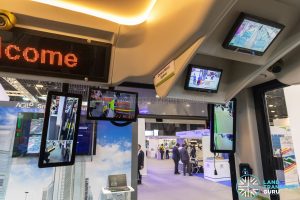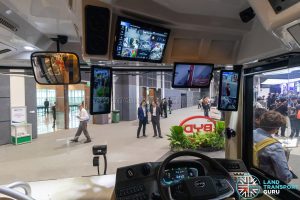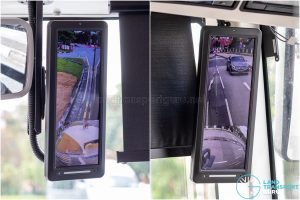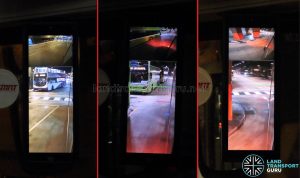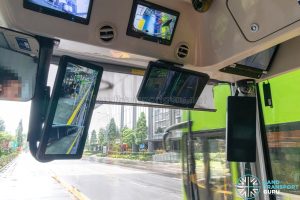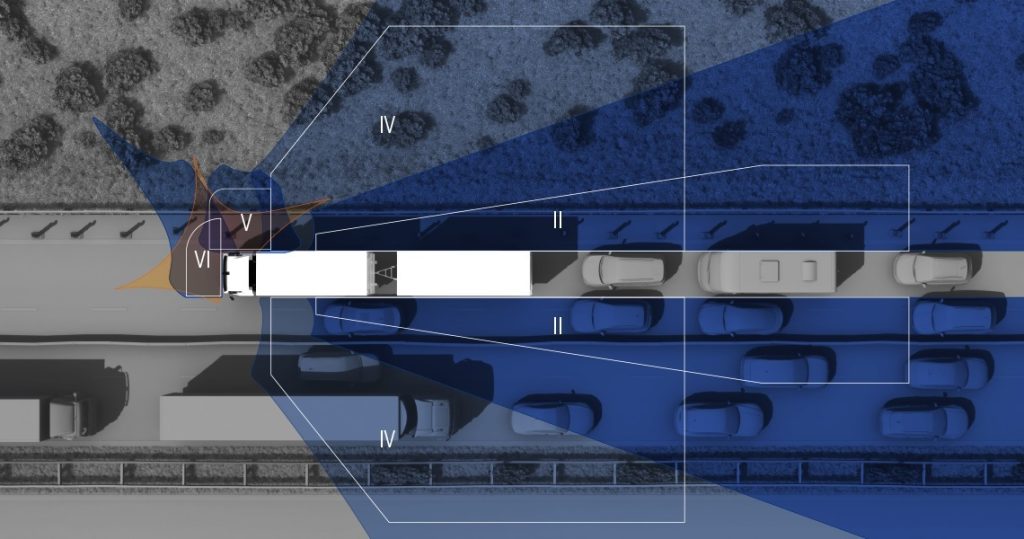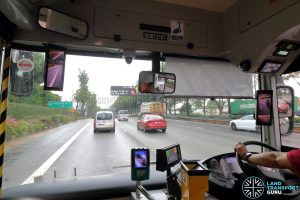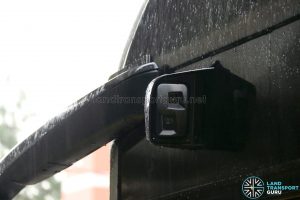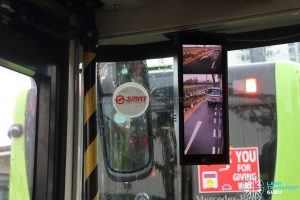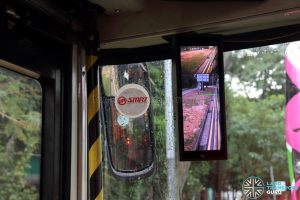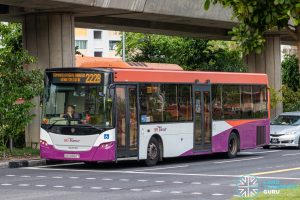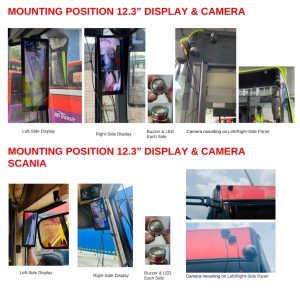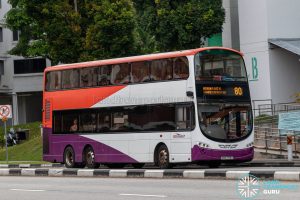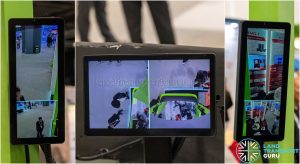Camera mirror systems, also called camera monitor systems, are digital replacements for traditional side mirrors. These systems link external cameras with display screens inside the vehicle, providing drivers with improved real-time views of areas around the vehicle.
In Singapore, following brief trials since 2019, the Land Transport Authority (LTA) has adopted camera mirror systems on new bus purchases in 2023, signalling the adoption of this new technology.
Benefits
Camera mirror system suppliers cite the following benefits:
- Low light visibility: Low-light technology allows drivers to see clearly in poor lighting conditions; such as at night, or indoors (e.g.within ITHs or multi-storey bus depots).
- Dynamic adjustment: Brightness and contrast are automatically adjusted based on ambient light conditions.
- Weather adaptability: Cameras provide clear visibility in rain, fog, and other adverse weather conditions. They also help drivers avoid glare or reflections that can be distracting.
- Better field of view: Camera mirror systems can provide a wider field of view than traditional mirrors, covering more blind spots.
- Collision avoidance: Some systems can be equipped with object detection alerting features for collision avoidance.
- Fuel economy: Reduced air resistance from the elimination of wing mirrors improves fuel efficiency.
- Reduced fatigue: Digital screens can be positioned within easy line-of-sight, for faster viewing and reduced strain over long periods.
- Accident reduction: Eliminates side mirror impacts as a frequent cause of vehicle accidents, thereby improving safety and vehicle uptime, and reducing the cost of procuring replacement mirrors.
The introduction of camera mirror systems is not without challenges:
- Cost: The initial cost of purchase may exceed traditional mirrors, and bus owners bear the costs of repairing or replacing these systems beyond a manufacturer’s warranty period.
- Reliability: Like all electronic systems, camera mirrors may malfunction cause a safety hazard and interrupt revenue service operations.
- Training Requirements: Drivers accustomed to traditional mirrors may require training to adapt to digital mirrors.
Road Traffic Regulations
In Singapore, the provision of mirrors and similar indirect-vision devices are cited in Rule 20 of the Road Traffic (Motor Vehicles, Construction and Use) Rules (R 9). For heavy vehicles, the LTA references the European Standard (ECE R46) for the provision of rear-view mirrors and proximity blindspot mirrors.
The following exterior mirror classes are specified within ECE R46:
| Class | Description |
| Class II | Main mirror (large) 1 on the driver’s side; 1 on the passenger’s side |
| Class IV | Wide angle mirror 1 on the driver’s side; 1 on the passenger’s side |
| Class V | Close-proximity mirror Passenger side blindspot; mounted at least 2 m above ground |
| Class VI | Front mirror Front-of-vehicle blindspot; mounted at least 2 m above ground |
In Europe, ECE R46 for large buses (vehicle class M3; buses with more than eight passenger seats and mass exceeding 5 tons) mandates the minimum provision of Class II mirrors, with classes IV, V and VI being optional.
Unlike heavy vehicles, buses in Singapore are not required to comply with ECE R46. The Road Traffic (Motor Vehicles, Construction and Use) Rules require the minimum provision of rearview mirrors on both sides (i.e. Class II mirrors under ECE R46), as well as a blind spot monitoring device, more specifically, “a device to enable the driver to have a clear view of the area within 300 millimetres of the front and 300 millimetres of the left side of the bus”, which is covered by Class V and VI mirrors under ECE R46. The requirement for blind spot mirrors took effect in 2015.
Nevertheless, ECE R46 is a useful industry standard when referencing the field of view provided by camera mirror systems.
First trials (2019)
Main Article: Smart-Vision Rearview Cameras
The first known trial of camera mirror systems on Singapore public buses came in March 2019, when Smart-Vision rearview cameras were trialled onboard an SMRT MAN A22 bus. These mirrors were installed to complement the regular wing mirrors.
Four cameras mounted on the bus (2 cameras on the left and right sides) generate a full side view of the vehicle in real time, inclusive of the blind spots of the bus. The system performs well in low-light conditions, offering much-improved visual clarity as compared to viewing from regular mirrors, which enhances the driver’s situational awareness on the roads.
SBS Transit Trial (2023–)
Starting in 2023, SBS Transit trialled camera monitoring systems on 31 buses plying Services 57 and 502, according to its 2023 Annual Report. The trial would be expanded to include more buses in 2024.
One of the systems installed was the TNT Surveillance T-ADM camera monitoring system, which was installed on several Scania K230UB, Mercedes-Benz Citaro and Volvo B9TL buses. The system uses two high-definition cameras mounted on either side of the bus, which feed real-time footage onto two 12.3″ displays inside the bus. The T-ADM system also alerts drivers to the presence of pedestrians and cyclists.
LTA Adoption
LTA’s 2023 procurement of electric buses under Contract PT601 will see all 420 new electric buses from BYD and Zhongtong equipped with camera mirror systems. Mounting points on the bus exterior allow wing mirrors to be installed if the camera system fails.
These buses are installed with the TNT Surveillance T-DM821 camera monitoring system, as identified within TNTS brochures at SITCE 2024. This system complies with ECE R46 and provides Class II, IV, V and VI coverage.
The system comprises three external camera units:
- Class II and IV cameras (driver side)
- Class II, IV and V cameras (passenger side)
- Class VI camera (front side)
At the driver’s cab, these cameras are linked to three display screens:
- Two 12.3-inch vertical displays on the left- and right side of the driver’s cab, providing Class II and IV coverage (representing side view mirrors with wide-angle perspectives)
- One 10.1-inch overhead display, providing Class IV and V coverage (representing the front and passenger side blindspots)
The left-side monitor is positioned closer to the driver compared to the traditional mirror placement, requiring bus drivers to adjust to this new viewing arrangement.
BYD BC12A04 buses with these new mirrors entered revenue service in December 2024. The first few days of revenue service also saw some buses prematurely withdrawn from service due to malfunctioning camera mirrors.
- Road Traffic (Motor Vehicles, Construction and Use) Rules | SSO Online
- Commercial Vehicles | LTA OneMotoring
- Heavy vehicles will be required to install more blind-spot mirrors to improve safety | Straits Times, 28 Feb 2015
- Regulation No 46 of the Economic Commission for Europe of the United Nations (UN/ECE) — Uniform provisions concerning the approval of devices for indirect vision and of motor vehicles with regard to the installation of these devices | UN ECE [pdf] [Accessed 10 Nov 2024]

